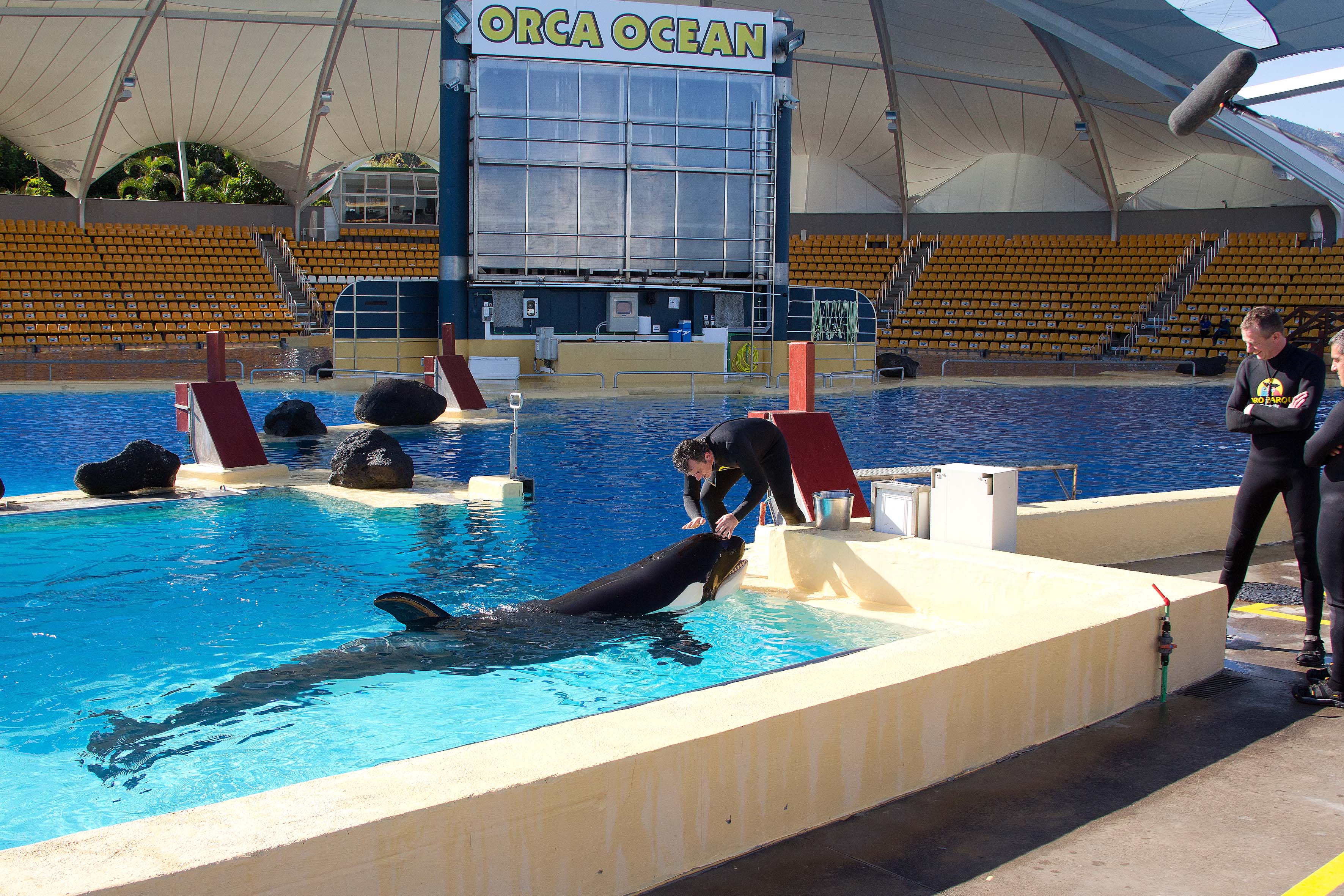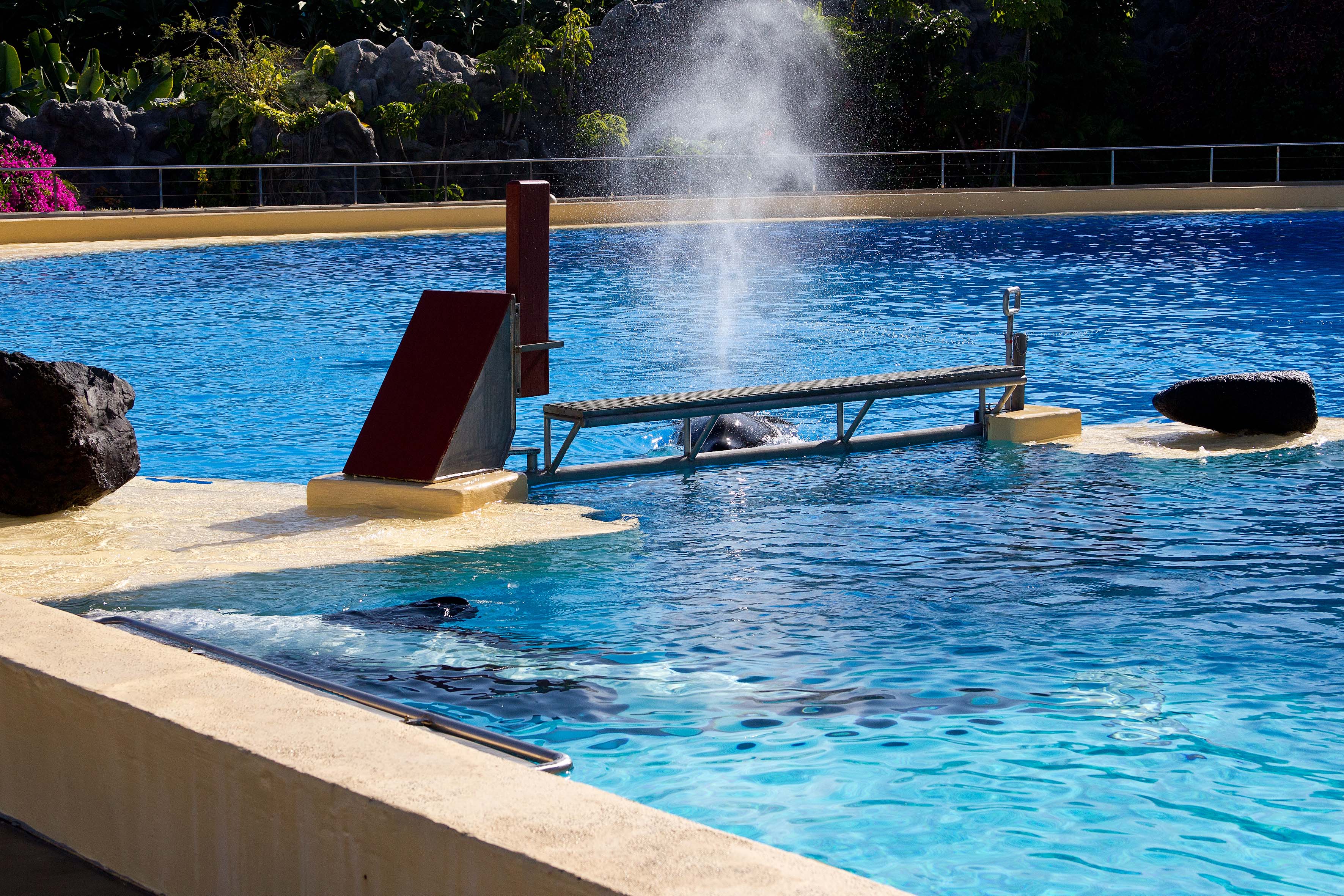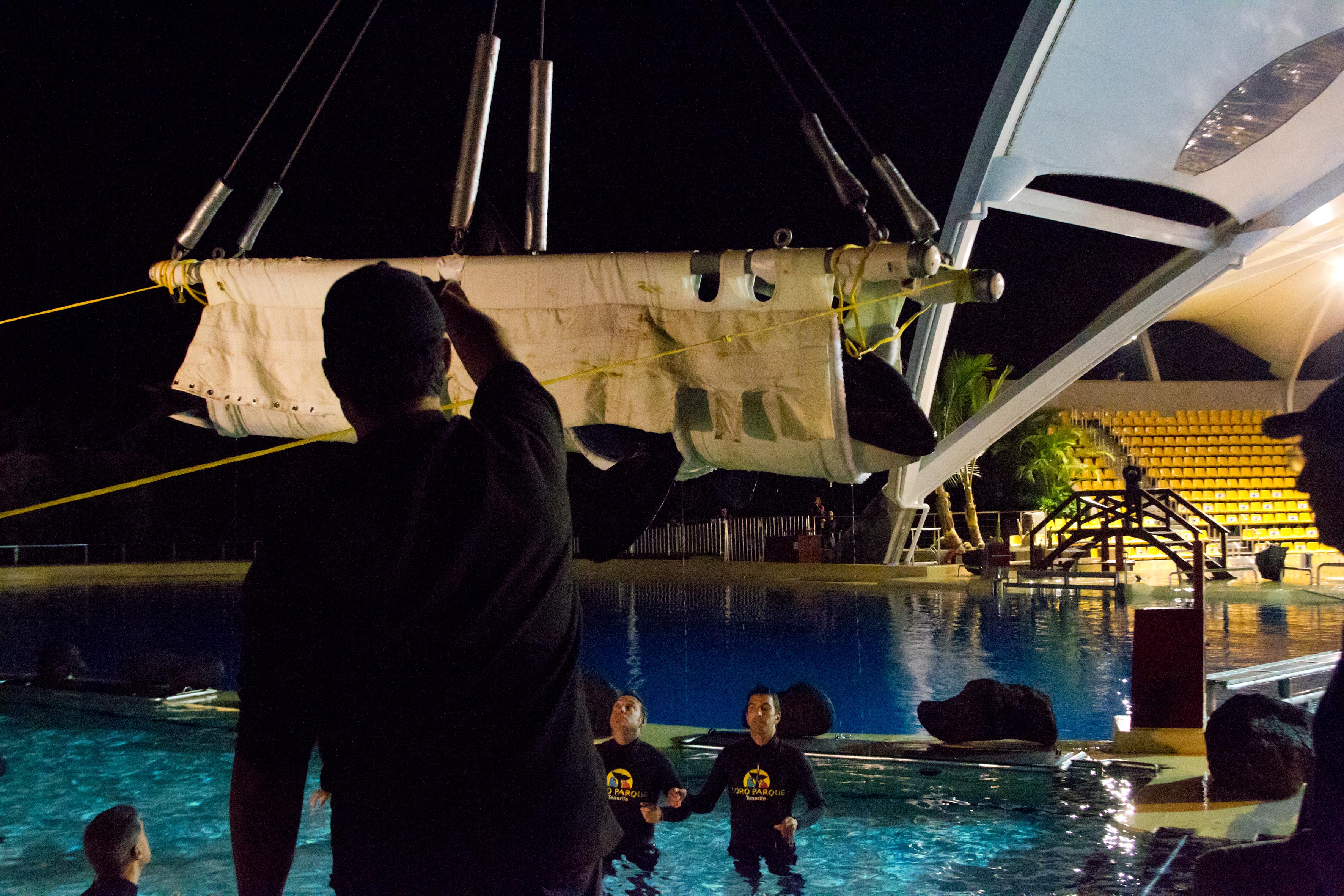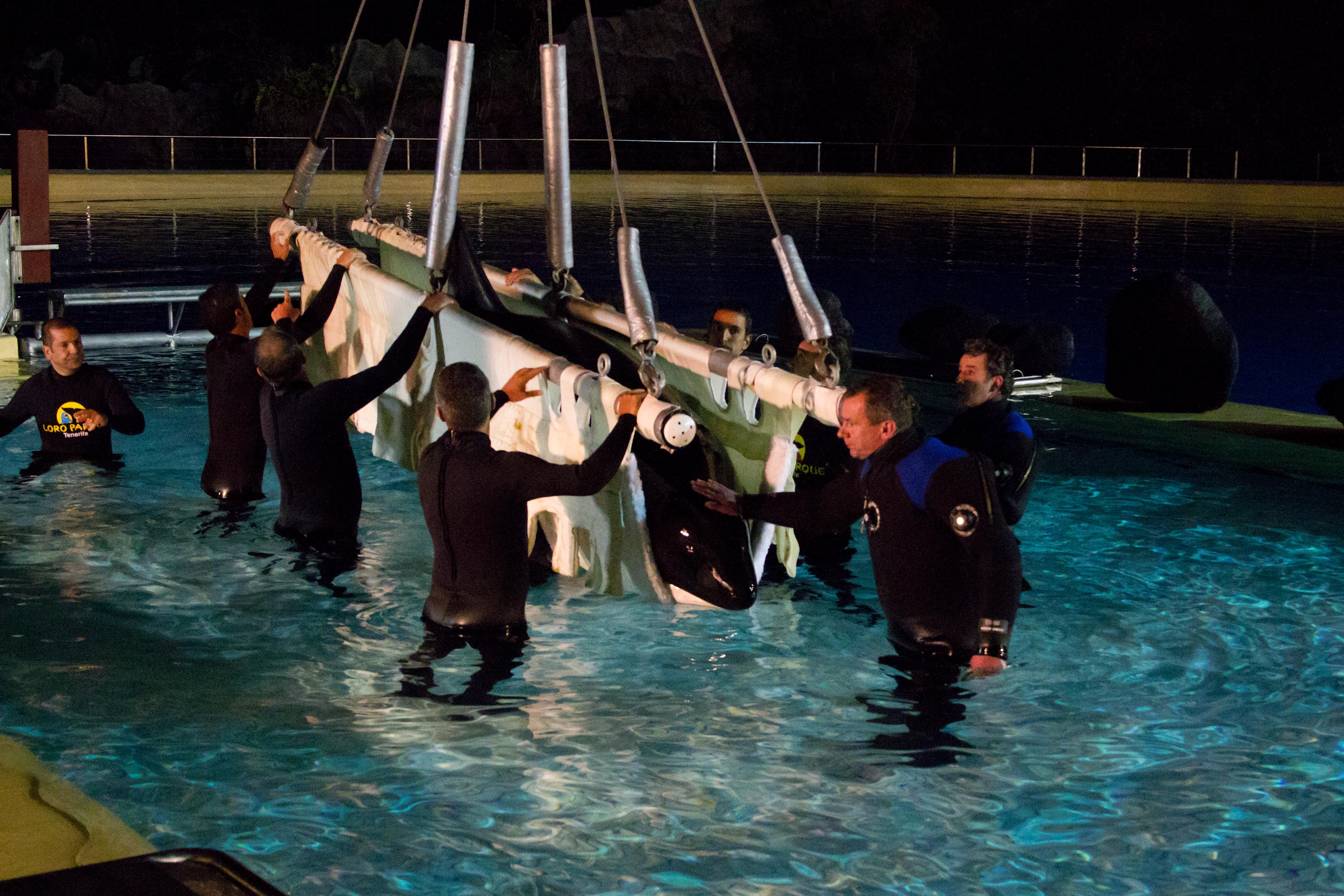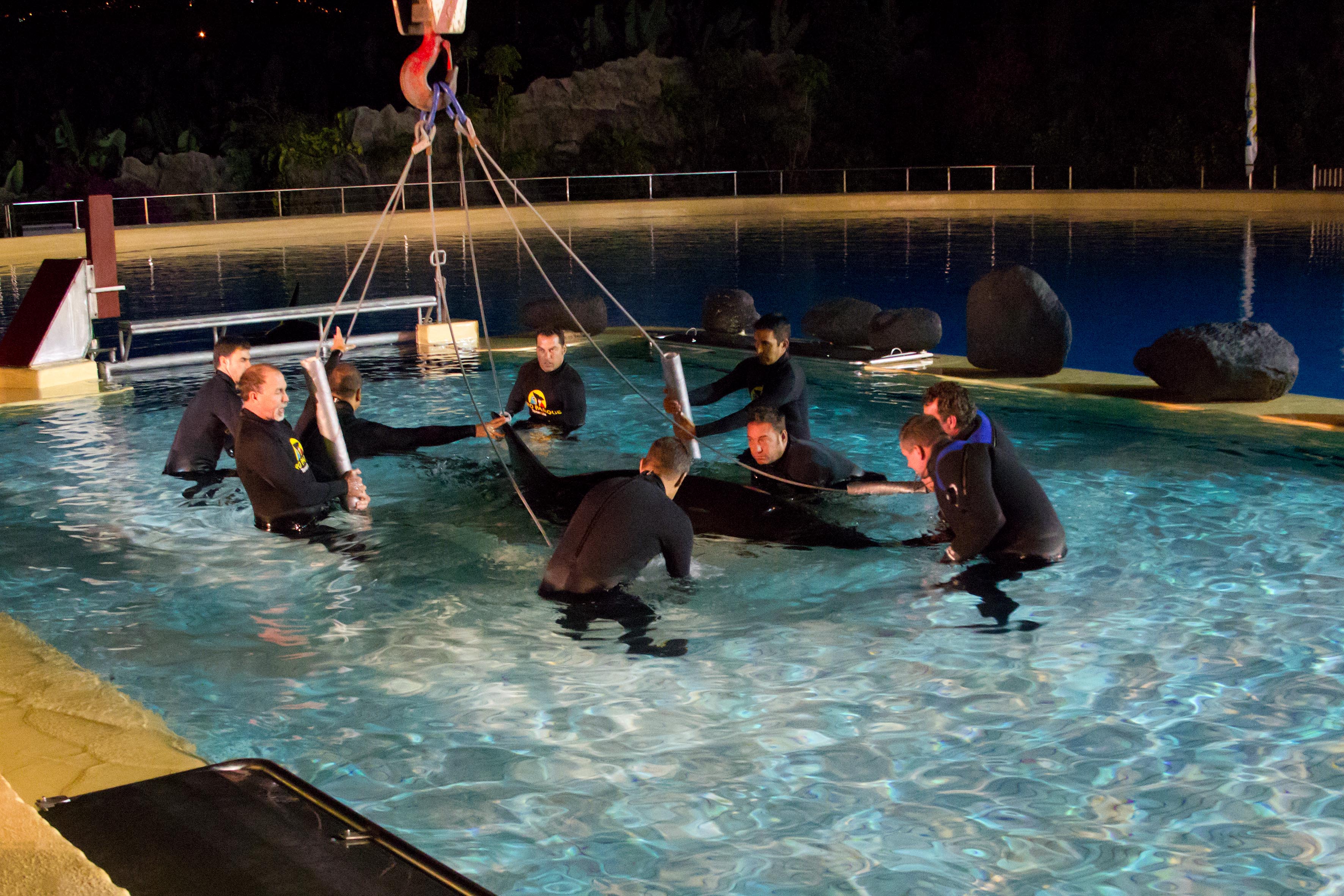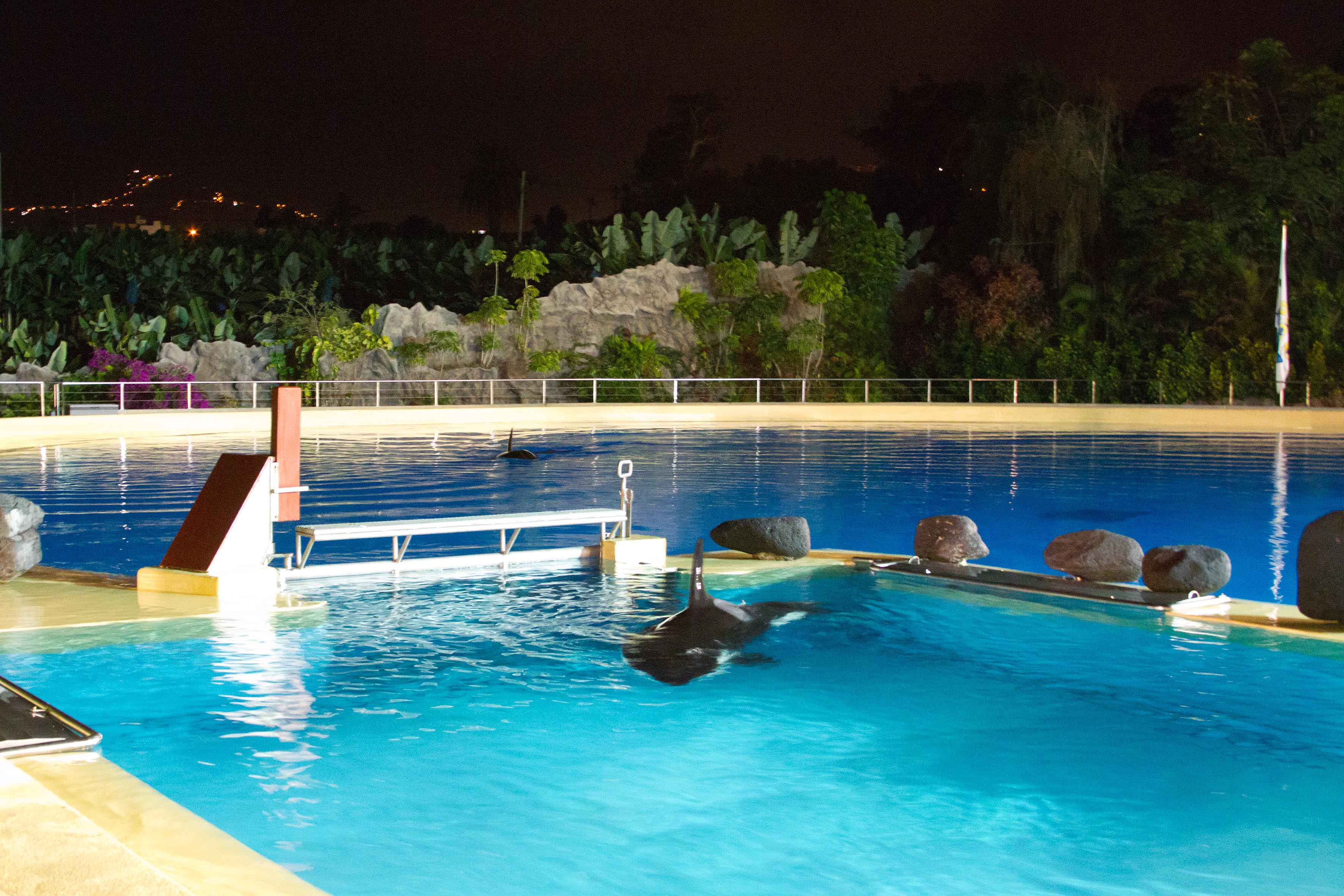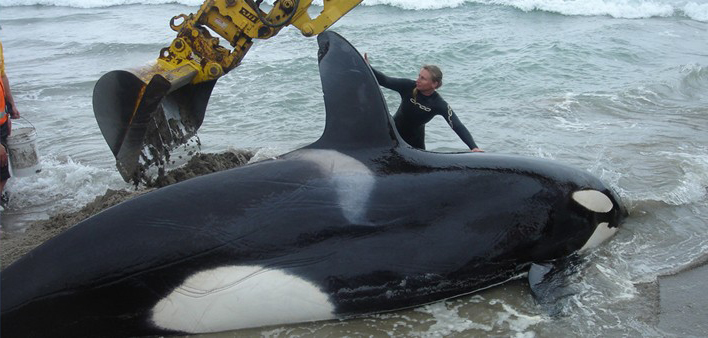
-
Rescue
In June 24th 2010 the Dutch coast guard spotted a young killer whale in distress in a shallow area of the Wadden Sea. Observation of this species in Dutch waters is considered rare, and the last stranding of an orca in Holland dated from 1963.
The coast guard requested the assistance of the Dolfinarium Harderwijk to organize a rescue operation of the animal, that resulted to be a young female subsequently christened “Morgan”. Morgan was found to be extremely underweight (at the time of the rescue weighted 430 Kg) but did not present major injuries or symptoms of a disease. Based on her length, which was compared with lengths and tooth growth layers of Norwegian killer whales from an International Whaling Commission report, she was estimated to be 1-2 years old. Once rescued, first priority was regaining weight, and in less than three months Morgan reached almost 700 Kg, which was more adequate for her length. (Watch Rescue)
-
Family pod and Consultancy
Given that there were no reports of killer whales regularly occurring in this area the question arose of where Morgan had come from. The Dolfinarium Harderwijk contacted Project NAKID (North Atlantic Killer Whale ID), a group of scientists from diverse European countries working with orcas. The principal role of this multinational group is putting together disperse studies and ID catalogues of Orcinus orca in the North Atlantic by collecting the data from each area. The final goal is to develop a library of photo-identification, genetic and acoustic data on NE Atlantic killer whales in order to study population structure and facilitate comparative studies between populations. So this group was the most appropriate to identify the origin of Morgan, and since September 2010 it started to perform Photo ID, genetic and acoustic studies. (See Family pod). The Dolfinarium Harderwijk gathered all the information produced about Morgan by NAKID and sent it to a panel of 7 scientific advisors for their advice on the suitability of Morgan as a release candidate (C.J. Camphuysen (Royal NIOZ, Netherlands), John K. B. Ford (Cetacean Research Program, Pacific Biological Station, Canada), Christophe Guinet (Centre National de la Recherche Scientifique, France), Markid Leopold (IMARES, Netherlands), Christina Lockyer (The North Atlantic Marine Mammal Commission, Norway), James McBain (Doctor in veterinarian medicine expert in killer whales USA), Fernando Ugarte (Head of Mammal and Bird Department of the Greenland Institute of Natural Resources)). These advisors had a broad range of experience among them and included some of the world’s leading killer whale researchers. As members of NAKID had helped prepare the information upon which the panel were basing their advice, no members of NAKID project were included in the panel, to maintain its independence. A report was then compiled summarising all the information and expert opinions that formed the basis for government advice and the final decision on whether or not to release Morgan. The scientists were unanimous that Morgan was not a good release candidate. The main concerns expressed were that she would not be accepted into a wild group (other than her family pod) and that on her own she would not be able to hunt successfully based on her extremely underweight state when she was found. The lack of information on the whereabouts of Norwegian killer whales, since the herring has changed its migration pattern, further complicated a possible release. Based on the unlikelihood that Morgan would have good chances of surviving if released, the Dutch authorities finally decided not to return Morgan to her natural habitat. (See Consultancy)
-
Although its originally stated intention was to return the animal to the wild, the Dolfinarium formally abandoned this option, based on the specialist advice that indicated that Morgan’s prospects for survival were essentially dependent upon her rejoining her family pod
-
WDCS protest in ASCOBANS
The whale and Dolphin Conservation Society (WDCS) submitted a release plan for Morgan to the Advisory Committee of the Agreement on the Conservation of Small Cetaceans of the Baltic, North East Atlantic, Irish and North Seas (ASCOBANS). ASCOBANS is the international treaty competent in the conservation of killer whales in the North Atlantic, and Holland is a party in this international convention, a subsidiary instrument of the Convention in Migratory Species (CMS). The Dutch Authorities submitted a letter stating that the only alternatives for Morgan where euthanasia or keeping her in captivity with other orcas. Although some parties suggested that “the sooner the animal could be released the better”, other doubted whether the case “was a priority to the Agreement”. WDCS was invited to resubmit the issue for consideration at subsequent meetings if so desired, but no documents were submitted to the 2012 Advisory Committee.
By the end of May 2011 technical staff from the Harderwijk Dolfinarium visited the facilities of Loro Parque to check if they would meet the standards to host a killer whale, and if it would be feasible to integrate her in the group of Loro Parque. After the visit they concluded that the management and installations would be ideal to host Morgan, and the conservation and education activities were in line with those established by the Biodiversity Department of the Dutch Government.((See WDCS protest in ASCOBANS) )
-
Permit to transfer
Harderwijk Dolfinarium requested a CITES permit to the Ministry of Agriculture of the Dutch Government to transfer Morgan to Loro Parque, as they evaluated it would be best and most suitable place to keep the conditions established by the Biodiversity Department of the Dutch Government.
-
Release plans
The Ministry of Agriculture of the Dutch Government granted the CITES permit for the transport of Morgan. The organization Orca Coalition (Orka Coalitie) presented a lawsuit to invalid the permit and release Morgan back to the sea. Orca Coalition presented a release plan, which was changed afterwards in various occasions, during the following hearings with the Dutch Ministry of Agriculture. (See Release plans)
-
Accusations
In the hearing appeal against the transport permit Orca Coalition criticized Loro Parque, insinuating that its orca group is unbalanced, that there is no conservation, research and education programme. (See Accusations Free Morgan).
Finally, the judge ruled that the procedure to issue the permit was not properly done, specifically because the Ministry didn’t gather all information correctly. The Ministry of Agriculture of the Dutch Government was obligated to set up an independent committee and repeat the procedure to grant the permit.
-
Letters supporting the work of Loro Parque Fundación
The independent committee met several times with representatives from the Dolfinarium, the Biodiversity Department, and the Orca Coalition. The committee requested to perform further bioacoustic analysis with an unpublished sound database from Norway killer whale pods. The committee also received new release plans from the Orca Coalition and the scientific analysis discouraging the release from the Harderwijk Dolfinarium. Loro Parque presented information about its conservation, research and educational activities, and letters supporting the research activities done. (See letters supporting the work of Loro Parque Fundación)
-
Dialect Studies
With all the documentation the independent committee of the Ministry of Agriculture of the Dutch Government reached the same conclusion as the previous one and approved the issue of the transport permit which could take place after a moratorium of 6 weeks. The Dolfinarium appealed against the moratorium before the court; Orca Coalition appealed again against the decision about the lawfulness of the permit. According to Orca Coalition there is a 65% coincidence with one pod of killer whales in Norway, although the exact location of the pod during the year is unknown, it was only seen once since 2005 and there is no of photo identification data which allows to confirm that Morgan belongs to this group. (See Dialect Studies)
-
Transport to Loro Parque
A judge analysed the case again, receiving the documentation from the three involved parts: Ministry for agriculture, Orca Coalition and Dolfinarium Harderwijk. During the last weeks of November one of the experts (John Ford) changed his opinion saying that with the sound data the liberation of Morgan should be assessed seriously, although he didn’t change his statement that even if the original group can be found, the introduction of the animal cannot be guaranteed. The verdict, favourable to the Dutch Ministry of Agriculture, said that the CITES permit was correctly issued and grants its use to transport Morgan to Loro Parque.
Morgan is transferred to Loro Parque and the integration process in the group starts. The competent Spanish Authorities are regularly reported on the status of Morgan and her socialization process until the full integration of Morgan in the group. (See Transport to Loro Parque).
-
Appeal
A second time, Orca Coalition appealed the court decision of November 2011 about the lawfulness of the CITES permit.
-
Integration
The integration process is considered accomplished by the technical staff of Loro Parque, and this is communicated to the competent Spanish Authorities. (See Integration).
-
Answer to Gran Simio
The European Commission responded to the inquiry of liberating Morgan realized by Proyecto Gran Simio in Spain, that in Morgan’s case EU legislation was strictly applied. (See Answer to Gran Simio).
-
Accusations
Orca Coalition appealed the second court decision against them, querying the validity of the CITES permit issued by the Dutch authorities. Dr. Ingird Visser visited the facilities of Loro Parque during one week and wrote a defamatory report about Morgan’s situation in Loro Parque. This report was presented before the court and published. Loro Parque responded in detail with scientific arguments to each of the allegations of the report (See Ingrid Visser’s accusations) and three valuations about Morgans condition of qualified veterinaries experienced in cetacean medicine (See Veterinary Reports) were given to the judge. From this moment on the critics of Orca Coalition focussed on the rake marks in Morgan’s skin, insinuating that those are proofs of Morgan being attacked, ignoring the multiple photos of killer whales with much deeper wounds, even a scientific article about killer whales with huge numbers of scars in their skin, written by Dr. Visser (See Rake Marks).
-
Audiogram
A group of independent experts in cetacean hearing were measuring Morgan’s hearing capacity, using Auditory Evoked Potential (AEP). They came to the conclusion that Morgan has an important hearing deficit, dissipating doubts which Orca Coalition had tried to spread. (See Audiogram). At the end of December the verdict is again favourable to the Dutch Ministry of Agriculture in granting the certificate to the Dolfinarium, and the court declared the appeal unfounded. In the ruling, the court admit as proven the fact that Loro Parque is a zoo within the meaning of Directive 1999/22/EC (Zoo Directive), which is to comply with the conditions formulated in this directive and which also serve the well-being of the animals in captivity. Regarding the commercial use of Morgan, the court ruling recognized the educational function of Loro Parque within the meaning of the Zoo directive, thereby refusing the appeal of Orca Coalition in which they pretended to affirm the exclusively commercial use.
-
Last appeal
Orca Coalition announced publicly that they won’t continue appealing the court decision which agrees with the Dutch Ministry of Agriculture. Free Morgan Foundation, the organization which had declared having only scientific objectives, takes it over and appeals for the third time against the last court decision, before the Dutch Council - the highest administrative instance of the country (See last appeal).
-
Scientific Research Report
Loro Parque presented a report about the research activities in which Morgan participated. (See Scientific Research Report).
-
Veterinarian report
Loro Parque applied to an independent veterinary, expert for marine mammal medicine, to prepare a report about Morgan’s situation, in order to present it before the court of the Dutch Council. (See Veterinarian report).
-
Morgan's Integration
At present Morgan is healthy and integrated in the group of orcas at Loro Parque (See Morgan at present). She is part of the conservation, research and education activities regularly accomplished with the orcas. These activities are regularly reported to the competent Spanish authorities and inspected yearly in order to comply with the regulations of the Spanish Zoo Law (31/2003, transposed from the Zoo Directive 1999/22/EC).
-
Final and unappealable verdict
On the 23rd of April 2014, the highest Administrative Court of the Netherlands confirmed once again the legality of Morgan’s transfer to Loro Parque with a firm and unappealable verdict. That was the fifth time the Dutch justice system confirmed the validity of the CITES permit after the continuous unfounded attacks and appeals presented by some organizations who call themselves animal advocates and systematically attack Loro Parque basing their arguments on false and malicious information.
(See the state Council’s statement)
(See the Open letter to the defenders of nature)
-
Attack from Free Morgan Foundation
Free Morgan Foundation begins a letter campaign targeting CITES authorities in Spain and the Netherlands, accusing Loro Parque of misinterpretation and non-respect towards the regulations established by the Convention on International Trade in Endangered Species of Wild Fauna and Flora. By means of this campaign, they request the isolation of Morgan from the males of her social group as Free Morgan Foundation views her reproduction illegal.
-
Judgement from CITES Spain
CITES authorities in Spain reply to Free Morgan Foundation’s campaign, ruling that there are no limitations on Morgan’s ability to breed. Furthermore, the institution dictates that the permit issued by their institution is the only binding document and that Loro Parque satisfies all the required parameters.
-
Attack from Free Morgan Foundation
Free Morgan Foundationis making a new attack insisting and presenting a formal complaint to the CITES authorities in the Netherlands in the hope that it declares Morgan’s permit to be invalid and, therefore, to be withdrawn. In order to achieve this, they assert that Morgan is living in poor conditions, has dental problems and is frequently aggressed by other orcas. They also claim that Loro Parque does not meet the research requirements established by the Convention.
-
Verdict of CITES Netherlands
Following a formal complaint, CITES authorities in the Netherlands dismiss the arguments presented by Free Morgan Foundation, denying their petition and insisting on the fact that CITES authorities in Spain are now responsible for supervising Morgan’s case.
-
Appeal
Free Morgan Foundation appeals the decision of the CITES authorities in the Netherlands, insisting that the permit is invalid in the case of Morgan and shall be withdrawn.
-
CITES Netherlands supports Loro Parque
Once again, CITES authorities in the Netherlands reaffirm their position and dismiss the appeal of Free Morgan Foundation as it does not include any new evidence or argument that differs from previous procedures.
-
Morgan’s pregnancy
In a statement, Loro Parque announces that Morgan is pregnant, her status being known following a uterus ultrasound during a regular veterinary check. Loro Parque publicly informs about her status due to the exceptional interest of general public for Morgan.
Reproduction is a right of every animal that cannot be denied, as it is a natural behaviour that should be only limited by individual welfare reasons or by the holding capacity of the zoological community. This right is furthermore included in Loro Parque’s Five Principles.
-
The Dutch Authorities support Loro Parque
The Dutch administrative and judicial authorities are ruling for the eighth time against the allegations of the activist organization Free Morgan Foundation. Thus, the Utrecht Court ruled that the CITES granted to Morgan by the Dutch authorities was granted to law and emphasizes, once again, that Loro Parque has top quality facilities and offers the animals excellent welfare conditions.
-
The Free Morgan Foundation brings a petition to the European Parliament
The Free Morgan Foundation brings a petition to the European Parliament regarding Morgan's case, and the oral response of the European Commission is clear: it is not necessary to change the regulations, as requested by the plaintiffs. In a previous petition, in 2012, the Commission stated already that, in the case of Morgan, all European regulations were strictly followed. Most of the deputies present were ready to close the petition and reject the request, making this the ninth (legal) defeat for activists in recent years.
-
Morgan’s pregnancy
Loro Parque already has everything prepared to receive Morgan's baby, which is expected to arrive after the summer. Both the park veterinarians and the external consultants, who are closely following Morgan's pregnancy, have worked to ensure that all aspects are under control to face any situation that may arise at the time of birth.
-
Resounding success with the birth of Morgan’s first calf:
Morgan has given birth to her first calf and both are in perfect health conditions. Since the birth Morgan has proved to be an exemplary mother swimming with her young one, attending her and minding her wellbeing. The first days are always critical in the life of any species, therefore we have a team of 20 people monitoring the progress of the calf around the clock.
-
Morgan's milk supply is not enough
Our priority is to ensure that the calf receives all the nourishment she needs for her wellbeing and optimal development. Since Morgan's milk supply is not enough, the team in charge of her evolution had to bottle-feed the calf at specific moments.
-
Morgan and her calf are separated
In spite of the continuous attempts to help Morgan increase her milk production, it is still low. As a consequence the caretakers have to bottle-feed the calf. To ensure proper feeding and proper development of the calf, the veterinary team decided to separate her from her mother and continue bottle-feeding her in the medical pool until she can eat by herself.
-
Morgan’s calf is growing healthy and strong
Morgan’s offspring continues to grow healthy and strong in the installations of Loro Parque. At the end of December, the calf already surpassed the weight of 250kg, and the milk feeding sessions are being conducted less often now – every six hours. At the same time, the keepers are no longer required to be with the young animal 24 hours a day (even though security personnel and the camera system of Loro Parque continue to ensure her well-being every single moment). Furthermore, the baby has started her first training with the keepers and she responds to it very positively.
-
Loro Parque is working with the University of Southern Denmark in a study with Morgan’s calf in order to try and establish when echolocation begins in the young orcas. The first experiments have already begun. There is no information whatsoever about young orcas, and some knowledge would help to better understand and protect these animals with more reliable risk-assessments on the impact of marine noise, its possible consequences, and even age estimates, based on sound recordings. Thus, by recording the calf periodically, one can begin to understand the development of its echolocation capacity - when it begins and how this sense evolves until it matches that of an adult orca.
-
Morgan and Ula are happy together in OrcaOcean
Loro Parque announces that the baby of Morgan is named Ula, a name of Celtic origin that means “Jewel of the Sea”. Morgan and Ula have a lot of affection towards each other and are enjoying being together in the installations of OrcaOcean.
-
The Committee on Petitions of the European Parliament closes, definitively, the petition initiated by Mathew Spiegel and Ingrid Visser (Free Morgan Foundation), with which they tried to prove that the CITES permit of the orca Morgan was being used incorrectly.
-
The Dutch judiciary has ruled in favor of Loro Parque in the case of the orca Morgan, confirming that the CITES permit should not be annulled as was requested by the Free Morgan Foundation. This resolution of the Supreme Court of the Netherlands is now the 10th time that the authorities decide against the claims formulated by the activist organization.
-
On September 22nd, Ula celebrates her first year of life in Loro Parque. Even though the first year is a complicated period as orcas’ immune system is very delicate, Ula is growing and learning in a surprising way.
-
The 10th anniversary of Morgan's rescue
Loro Parque commemorates the 10th anniversary of Morgan's rescue with the release of the documentary telling the moving story of how this animal went from being on the brink of death to finding a new life in our animal embassy.
-
Morgan the Brave Orca
The animated short film “Morgan the Brave Orca” directed by Marcos Martín Muñoz is released, aiming to tell her story in a unique way, as well as to raise awareness about the serious consequences that underwater noise can have on animals.
-
Ula's Death
With profound sadness, the Loro Parque family loses Ula after a long illness.
-
Morgan participates in research on animal welfare markers
In this study, the cortisol levels of Loro Parque orcas were measured using skin scraping techniques to understand the multiple threats faced by specimens living in the wild. In this case, Morgan acted as an ambassador for her fellow orcas in the wild.
-
Morgan participates in a study analyzing oxygen consumption in orcas.
The research aims to understand how much energy they use at rest and while moving, a key factor in understanding their nutritional needs and assessing how human and natural disturbances affect their health and survival.
-
Morgan gives birth to her new calf.
Morgan gives birth to her second calf, and both are in perfect health. From the very beginning, Morgan demonstrates a strong maternal instinct, swimming alongside her calf, nursing it and caring for it with dedication. The first few days are always critical for any species, so a team of experienced veterinarians and keepers is monitoring its progress 24 hours a day.



